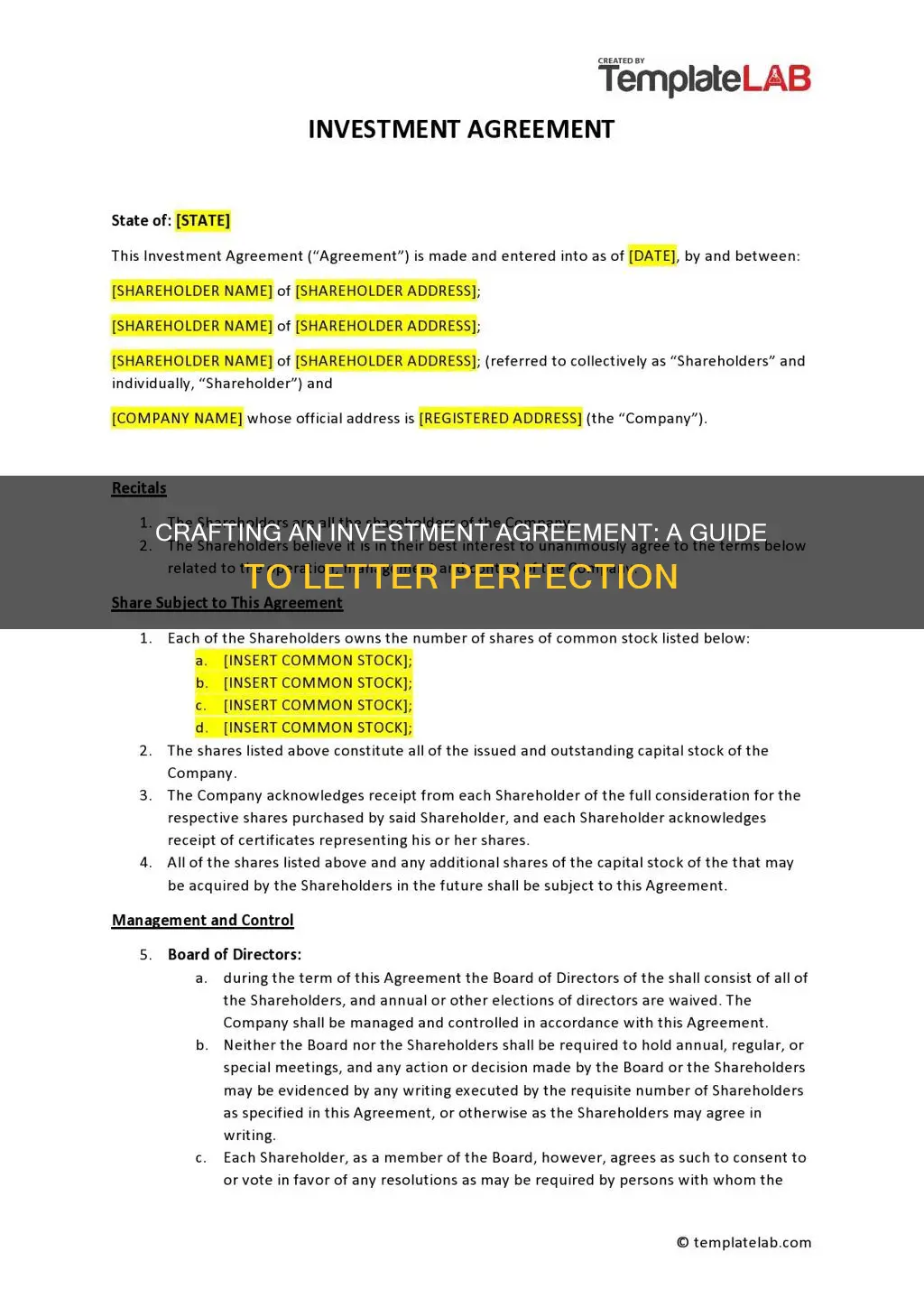
An investment agreement is a crucial document for any business venture as it outlines the terms and conditions of the investment, including the investment amount, payment terms, duration, and termination clauses. It is a legally binding agreement between two or more parties that sets out the rights, duties, and obligations of each party, protecting their interests and providing a clear plan for managing the relationship between investors and the company.
When creating an investment agreement, it is important to identify all parties involved and their respective roles, as well as establish the purpose and goals of the agreement. The agreement should also clearly define the rights, responsibilities, and expectations of each party, including the authority in decision-making, financial commitments, and reporting obligations.
To ensure the agreement is comprehensive and robust, it is essential to specify the type of investment, the amount of investment, the duration of the investment, and any restrictions or limitations. The agreement should also address the return on investment, potential risks and rewards, and the responsibilities and liabilities of each party in the event of a breach of contract.
By following these steps and carefully considering each element, individuals can create a well-drafted investment agreement that protects all parties involved and helps ensure the success of the business venture.
| Characteristics | Values |
|---|---|
| Purpose | The purpose of an investment agreement letter is to outline the terms and conditions of an investment opportunity and to protect both the investor and the investee. |
| Content | The letter should include the following: a description of the investment opportunity, the amount of money being invested, the terms of the investment (including any vesting periods or milestones), the rights and responsibilities of both parties, and the expected returns or outcomes. |
| Format | The agreement letter should be written in a clear and concise manner, using plain language that is easy to understand. It should be formatted as a formal business letter, with headings and bullet points to break up the content and make it more readable. |
| Tone | The tone of the letter should be professional and amicable, reflecting the seriousness of the agreement while also maintaining a friendly and collaborative tone between the investor and the investee. |
| Legal Considerations | The letter should be reviewed by a legal professional to ensure it complies with any relevant laws or regulations and to protect the interests of both parties. It should include a clause stating that the agreement is subject to the laws of a specific jurisdiction. |
| Signature | Both parties should sign and date the agreement letter to indicate their acceptance of the terms. It is common to have the letter signed by authorized representatives of each party, such as the CEO or a member of the investment team. |
| Attachments | Any supporting documentation or exhibits referenced in the agreement letter should be attached, such as financial projections, business plans, or due diligence reports. |
| Review and Amendment | The agreement letter should include a clause that allows for review and amendment by both parties, specifying a process for making changes and the required format (e.g., written requests or amendments signed by both parties). |
| Confidentiality | A confidentiality clause should be included to protect sensitive information exchanged between the parties during the investment process. |
| Dispute Resolution | The letter should outline a clear process for resolving any disputes that may arise, such as mediation or arbitration, and specify the jurisdiction under which any disputes will be handled. |
| Termination | The agreement letter should include the terms under which the investment agreement may be terminated, including any consequences or penalties for early termination. |
What You'll Learn

Outline the purpose and goals of the agreement
The purpose of an investment agreement is to document the terms of an investment between two or more parties. It is a legally binding contract that outlines the rights, obligations, terms, and conditions of an investment transaction. It is important to have an investment agreement in place to protect the interests of all parties involved in a venture and to provide legal protection in case any disagreements or disputes arise.
When establishing the purpose and goals of the agreement, it is important to identify the parties involved and their respective roles. This includes determining who the investor(s) and recipient(s) are, as well as outlining the roles, responsibilities, and expectations of each party. For example, it should be clear whether the investor will have voting rights or a seat on the company's board of directors.
The agreement should also specify the objectives of the investment, including the expected returns and the duration of the investment. It is important to be clear about what type of investment is being made, such as stocks, bonds, equity, or debt, and to define the terms and conditions of the investment, including any restrictions or limitations.
Additionally, the agreement should outline the rights and obligations of each party, including voting rights, participation in decision-making, information sharing, and confidentiality. It should also address how disputes will be resolved and include an exit strategy in case of unresolvable disputes or business insolvency.
Smart Investment Choices: Strategies for Success
You may want to see also

Define the rights and responsibilities of each party
When making an investment agreement letter, it is important to define the rights and responsibilities of each party involved. This section is crucial as it ensures that the rights of the parties are clearly defined and protected, facilitating effective governance and collaboration throughout the investment process. Here are some key points to consider:
- Voting rights: Specify the voting mechanisms and rights attached to different classes of shares. This is crucial for making critical decisions that will affect the company's future.
- Participation in decision-making: Outline the extent to which each party can participate in making decisions within the company.
- Information sharing: Define the type of information to be shared and the frequency of such sharing.
- Board representation: Determine if the investor will have a seat on the company's board of directors and the extent of their involvement in strategic or operational decisions.
- Non-compete and non-solicitation obligations: Outline any restrictions on the investor's ability to compete with the company or solicit its employees.
- Restrictions on transfer: Detail any limitations on the investor's ability to transfer their shares or ownership interest.
- Confidentiality: Establish provisions to protect the confidentiality of sensitive information exchanged between the parties.
- Compliance with laws and regulations: Ensure that both parties comply with all relevant laws and regulations.
- Dispute resolution: Outline a clear process for resolving disputes that may arise during the investment period, including negotiation, mediation, or arbitration.
- Exit strategy: Define the conditions under which the investor can exit the investment and the potential consequences of such an exit.
By clearly defining the rights and responsibilities of each party, you can create a transparent and fair investment agreement that protects the interests of both the investor and the company.
Creating a Mock Investment Portfolio: A Step-by-Step Guide
You may want to see also

Detail the terms of the agreement
The terms of the agreement are the most important part of an investment contract. This is where you will include the specifics of the agreement, such as how long the investment will last, the expected returns, and any other conditions that need to be met. Here are some key points to consider when detailing the terms of the agreement:
- Investment Amount and Payment Terms: Outline the investment amount, including the currency and any payment schedules, milestones, or conditions that must be met for the release of funds.
- Duration and Termination: Specify the duration of the investment and any conditions or events that could lead to early termination. Define the process for terminating the agreement and the potential exit strategies for the investor.
- Rights and Responsibilities: Clearly define the rights and responsibilities of each party involved, including voting rights, decision-making participation, information sharing, and board representation.
- Confidentiality and Non-Disclosure: Establish provisions to protect sensitive information exchanged between the parties. Outline the types of information considered confidential and the obligations of both parties during and after the investment period.
- Dispute Resolution: Outline the mechanisms for resolving disputes that may arise during the investment period. Include the choice of jurisdiction, applicable laws, and any requirements for legal proceedings and reimbursement of legal fees.
- Performance Metrics and KPIs: Define any performance metrics or key performance indicators (KPIs) that will be used to evaluate the progress and success of the investment.
- Reporting and Accountability: Detail the reporting and accountability obligations of the investee, specifying the frequency of financial and operational reporting to be provided to the investor. Include any requirements for independent audits and external assessments.
- Conditions and Milestones: Outline any conditions or milestones that need to be met by the investee to access the investment, such as achieving specific financial targets or meeting regulatory requirements.
- Conversion Rights: If the investment involves convertible notes or equity financing, specify the conversion rights for the investor.
- Voting Rights: Define the ownership percentage or shares allocated to each investor and the associated voting rights.
- Restrictions and Prohibitions: Identify any restrictions or prohibitions on the transfer of assets or shares.
- Governance and Decision-Making: Outline the composition and responsibilities of the board of directors, the process for board meetings, and the role of the investor in strategic and operational decisions.
Remember to use clear and concise language throughout the agreement to avoid misinterpretation and ensure that all terms are well-defined to prevent disputes.
Investing vs. Trading: Which is Better for Indians?
You may want to see also

Sign the agreement
Signing the agreement is the final step in the process of creating an investment agreement. Once the agreement is complete, each party should sign and date the document to make it legally binding. This step ensures that all parties involved are committed to the terms and conditions outlined in the contract.
It is important to note that the signing process may vary depending on the specific requirements of the agreement and the number of parties involved. In some cases, there may be additional steps, such as notarization or witness signatures, to ensure the validity of the agreement.
- All parties should carefully review the agreement before signing: It is crucial that each party involved in the investment, including investors, the company, and any other stakeholders, thoroughly read and understand the agreement. This ensures that everyone is aware of their rights, obligations, and the potential risks associated with the investment.
- Obtain necessary signatures: Besides the signatures of the primary parties, there may be instances where witnesses or guarantors are required to sign the agreement. This is often the case when the investment involves a significant amount of money or complex financial structures.
- Ensure compliance with legal requirements: The investment agreement should comply with all relevant laws and regulations. This includes ensuring that the agreement is in line with securities laws, tax regulations, and any industry-specific legal requirements. Seeking legal advice or consulting with a financial advisor can help ensure that the agreement meets the necessary legal standards.
- Consider electronic signature options: With the advancements in technology, electronic signatures are becoming increasingly common. Using electronic signature software or digital signature platforms can streamline the signing process, especially when dealing with remote investors or multiple parties involved.
- Establish a secure record-keeping process: After the agreement is signed, it is essential to establish a secure and organised system for storing the document. This ensures that the agreement can be easily accessed and referred to in the future. Consider using password-protected files or secure cloud storage solutions to safeguard the agreement and maintain its confidentiality.
- Facilitate a smooth signing process: Make the signing process as seamless as possible for all parties involved. Provide clear instructions on where to sign, initial, or date the document. If there are multiple signature pages, clearly number the pages to avoid confusion.
By following these considerations, you can ensure that the signing of the investment agreement is properly executed, meeting the legal requirements and protecting the interests of all parties involved.
The Eastern Promise: Investing in China and India's Future
You may want to see also

Include a glossary of key terms
A glossary of key terms is an essential component of an investment agreement. This section defines important terms used throughout the document for easy reference, making the agreement more digestible, especially if it contains complex industry-specific terminology. Here are some tips for creating a comprehensive glossary for your investment agreement:
- Define Technical Terms: Include definitions for technical terms, industry jargon, and acronyms used in the agreement. This ensures that all parties involved clearly understand the meaning of these terms and reduces the risk of misinterpretation.
- Clarify Legal and Financial Terms: Investment agreements often contain legal and financial terminology that may not be familiar to all readers. Provide clear and concise definitions for these terms to ensure a common understanding among the parties involved.
- Contextual Explanations: When defining terms, provide contextual explanations that relate the term to the specific investment being discussed. This helps readers understand how the term applies within the scope of the agreement.
- Cross-References: If certain terms or concepts require additional explanation, include cross-references to relevant sections of the agreement, appendices, or external documents. This allows readers to easily find more detailed information if needed.
- Consistency: Ensure that the definitions provided in the glossary are consistent with how the terms are used throughout the agreement. This maintains clarity and avoids confusion.
- Accessibility: Organise the glossary in alphabetical order or group similar terms together to make it easily navigable. This ensures that readers can quickly find the definitions they need, improving the accessibility of the agreement.
- Updates: As the investment evolves, new terms may emerge, and the definitions of existing terms may change. Ensure that the glossary is regularly reviewed and updated to reflect any changes in terminology or industry standards.
- Standardisation: Follow standard definitions from reputable sources, such as regulatory bodies, industry associations, or established textbooks. This ensures that your glossary aligns with widely accepted terminology and reduces ambiguity.
- Translation: If the investment involves international parties, consider including translations of key terms in multiple languages. This helps all parties understand the terms, even if they are not fluent in the primary language of the agreement.
- Dynamic Nature: Recognise that the field of investment is dynamic, and new terms may emerge over time. Stay updated with industry developments and incorporate emerging terminology into your glossary accordingly.
- Avoid Overly Complex Definitions: While providing comprehensive definitions is important, avoid overly complex or technical explanations that may confuse readers. Strive for clarity and simplicity in your definitions to ensure they are accessible to all parties.
Investing Wisely: Building a Fortune with Savvy Strategies
You may want to see also
Frequently asked questions
An investment agreement is a legally binding document that outlines the terms and conditions of an investment between two or more parties. It helps to protect the interests of all parties involved and ensures everyone is working towards a common goal.
The agreement should include the names and roles of all individuals or companies involved in the investment, including investors, the company receiving the investment, and any other stakeholders.
The agreement should include the investment amount, payment terms, duration, termination clauses, confidentiality provisions, and dispute resolution guidelines. It should also outline the rights and responsibilities of each party.
A well-drafted investment agreement protects all parties involved in the investment and ensures everyone is on the same page. It also helps to build trust between parties and can prevent legal issues from arising.
Yes, it is highly recommended to seek professional advice from both an accountant and a lawyer when creating an investment agreement. An accountant can help with the financial aspects, while a lawyer can provide legal advice and ensure the agreement complies with applicable laws.







